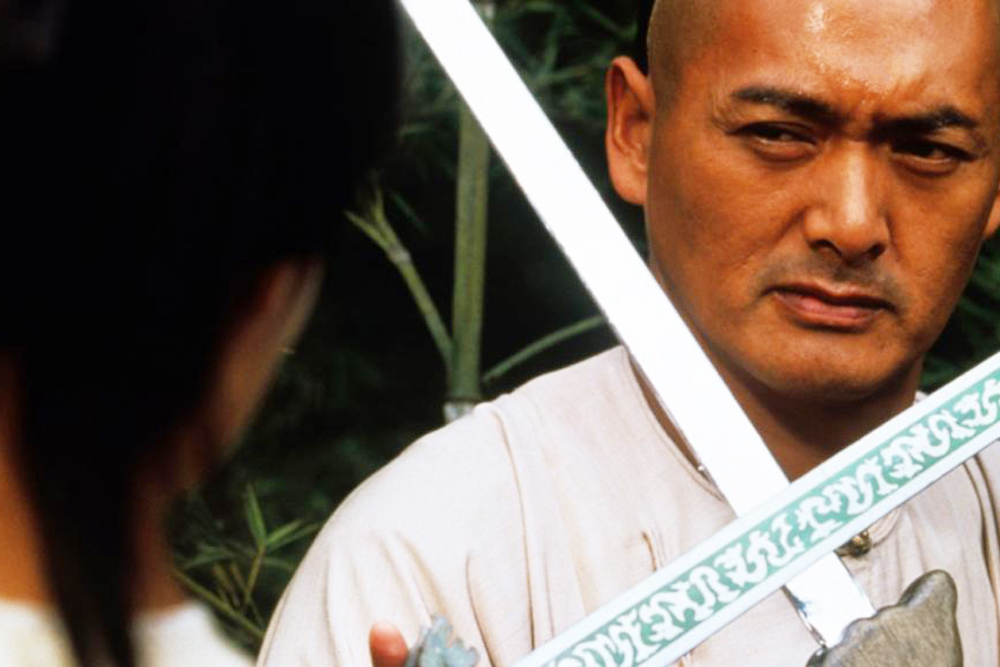Vanguard editors Matthew N. Andrews (Arts & Culture) and Andrew D. Jankowski (Online & Social Media) attended NW Film Center’s sold-out screenings of The Holy Mountain (1973).
Andrew narrates, Matthew comments:
I attended the Sept. 17 screening of The Holy Mountain with Nick Mattos, a former PQ Monthly columnist and arts & culture writer. I know that Matthew and Nick are Jodorowsky fans, but I knew next to nothing about Jodorowsky’s films except the basics: They’re symbolic, colorful, visually rich and likely to send any MPAA disciple into a medical emergency. [To say nothing of the brick it would make poor old Will H. Hays shit—MNA]
I’d never attended a NW Film Center screening. I meant to attend at least one of the David Lynch Retrospective films, but I never made the time. I also meant to see Santa Sangre (1989) and Endless Poetry (Poesia Sin Fin) (2017) when they screened at other Portland theaters, but same story. Whitsell Auditorium is a large, acoustically quiet theater with chairs of comparable comfort to 5th Avenue Cinemas (I haven’t been there since before any seat remodeling, and I’m closer to seven feet tall than six, so take that information for what it is). [I’m about as wide as Andrew is high, and I love Whitsell’s seats—MNA]
PSU Assistant Professor Amy Borden’s avant garde cinema class is probably the most valuable film course I’ve taken. I learned how to disassociate cinematic reality from natural reality, what to watch for in a plotless film, and the truth that any stimuli you experience—from your neighbor’s reactions to the mechanical sounds of the projector—can inform your film reading.
All this to say: The Holy Mountain was a difficult, spiritual art journey, and I left the theater a changed being, not only having seen a film but at many times having felt seen by a film featuring chambers constructed as eyes staring back at the audience. [We’re certain that was Jodo’s intent—MNA]
There’s not much plot of speak of: The plot diagram one usually learns in tenth grade English class mostly just navigates us through the religious and cultural imagery permeating the film. It’s hard to decide on images to discuss that won’t give away the experience. I really wish I had written down which of the planetary avatars’ lives was referenced for Santigold and Nima Nourizadeh’s “L.E.S. Artistes” music video. [The first part is Jodo’s alchemist himself, the part with all the fruits and body horror is from the sequence when studly Axon (Richard Rutowski)’s Unsullied Neptune Youth don their riot gear and face off with protesters in the streets—MNA]
The two themes that struck me the most in The Holy Mountain were the presence of non-human intelligences and the idea of between-stages, something I first learned about through Stephen Nachtigall’s zero vine Littman Gallery exhibition last January. [The theme that struck me most appeared early on, the Jesus character carrying around a plaster-cast copy of himself hanging on the cross, fractally bearing his own crucified image. I’m a sucker for blasphemous and absurdly recursive imagery—MNA] [@MNA And wasn’t it also made of pork-sourced wax?! Let’s look at that too!!!—ADJ]
Animals occupy the same space as human actors in The Holy Mountain, the most obvious example being the frog and lizard reenactment of Spain’s American conquest. The audience audibly “aww”ed at the lizards in their indigenous national costumes, but I didn’t hear anyone react as the conquistador frogs overwhelmed the lizards, the pyramids gushing fountains of blood and the landscape violently exploding (likely taking all the frogs and lizards with it). The Thief (Horacio Salinas) [that’d be the Jesus avatar, who is also The Fool and much else besides—MNA] croaks and groans across the ruined, bloody stage like an amphibian, driving home the point that European conquest was not quite a matter of two different species performing in cute costumes against their will.
I most vividly remember a crane walking around in one of the eye chambers, because it moved with the same semi-aware motions and a similarly unknowable, Brakhage-unfixed gaze as the sleep-deprived/stoned actors. The camera angles and staging made me feel like a god, seeing every corner of a chamber from above. [Also Jodo’s intent: Know ye not that thou art gods?—MNA]
The between-stages theme is most obvious in the alchemical symbolism and the characters’ spiritual journeys. Both of these processes in The Holy Mountain require human ingredients as conduits for change. The spiritualists must lose themselves until they find themselves; in one striking scene, shit and sweat are drawn from a hyperbaric chamber pumping boiled shit fumes back in on the nude querent (which, if there’s only one visual metaphor allowed for artistic academic bubbles gone wrong, what other would be better?). [I love this scene’s punchline, a holographic synecdoche for the whole damn movie: “You are excrement. You can change yourself into gold.”—MNA]
If The Holy Mountain obviously exposes the artifice of special effects in cinema (using fruit to resemble organs and exposed tubing to pump blood), then it also reveals the grueling physical and logistical labor which goes into staging such scenes, and the use of body horror is a way to connect the audience to the light-and-pigment images projected before them. [Cronenberg is pretty great at this too—MNA] I really, really hope that The Alchemist (Alejandro Jodorowsky) didn’t actually rip an acrylic nail off Leticia Robles’s or Connie de la Mora’s thumb, because that was just as bad as witnessing staged castrations or the flesh being cut from a living horse (staged? one hopes so), if only because of the long tradition of ignoring femme pain and femme labor. (Consider also that both women are credited under the same role). Their pain, along with the surrealist portrayal of a limbless man (real-life multiple amputee Basilio González, who is not properly credited), represents The Thief’s emotional state; they also signal how journeys of spiritual enlightenment can be brutally violent, and Travelers can lose themselves and become symbols, like The Alchemist’s taxidermic goat throne. [This union of physical and spiritual cruelty is one of Jodo’s special touches, running through all his work, and the one that would probably get him into more trouble if he weren’t so goddamn charming. See also: careers of G.I. Gurdjieff, Joshu Sasaki, Alfred Hitchcock, et alia—MNA]
Speaking of moments that made me wince and look away from the camera, let me now address my fellow audience members: Please, please I’m begging you, learn how to act like you’ve never before seen tiddies or ass cheeks or simulated sex or queer displays of affection or centenarian hermaphrodites with jaguar-head tiddies. The gentleman next to me who started snoring as he slept was less annoying. Most of the time I tuned the audience out, though, and became the only being in the whole theater, engaged in mutual gaze with Jodorowsky’s 40-plus-year-old immortal avatar. [Ha! He trapped you, too, eh?—MNA]
I don’t want to spoil The Holy Mountain‘s climax. It was so special. [I won’t spoil it either, but I don’t mind hinting that it was good enough for Monty Python to steal it at least twice—MNA] All I will say is that literally anyone who offers you immortality is not offering you what you think. For The Holy Mountain, there is indeed real alchemy and real binding magick and the real immortality achieved by creatives like Sylvia Plath and Amy Winehouse. [I have to add Prince and Bowie to this litany—MNA] It is real and attainable. You will lose every claim to your body and your conscious autonomy, but you will live forever (assuming the medium you’re bound to survives). [“You are excrement. You can change yourself into gold.”—MNA]
As Nick and I exited Whitsell Auditorium, rejoining the real world waiting for us, we ran into not only XRAY.FM host and DJ Vera Rubin and her date, but the large-scale Keith Haring display outside Whitsell Auditorium that we all somehow missed when we found our seats. Rubin joked about recognizing the pattern from a pair of H&M shoes. We all laughed and took in Haring’s black and red lines, and the white space between them. After watching almost 120 minutes of psychedelic cinema, all the lines appeared vibrant, crackling like electricity. I personally love queer artifacts at least a decade old. I feel in tune with the embedded queer energy from another era still affecting the present. Spotting Keith Haring before walking beneath larger-than-life realistic orchid sculptures was the perfect art history companion to The Holy Mountain‘s transcendental offerings. I didn’t just see a movie: The movie saw me. [I never noticed the Haring display either. And I think we can add him to that list of immortals.—MNA]
The Holy Mountain screened as the first film in NWFC’s Genrified! series, which continues in October and December with cult classics Near Dark, Cat People, and Suspiria. Click here for more info.
Andrew D. Jankowski is the PSU Vanguard‘s online & social media editor. His areas of focus are arts & culture, breaking news, photography and guide columns. Andrew is the PR coordinator for PSU’s Littman + White Galleries. Andrew also writes for PSU Chronicles.
Matthew N. Andrews is the PSU Vanguard‘s arts & culture editor. His areas of focus are music, film, and real-world magick. Matthew is a student leader of the PSU Composers Consort and Students United for Nonviolence. Matthew also writes for Oregon Arts Watch.






